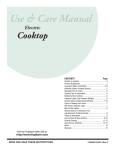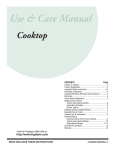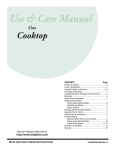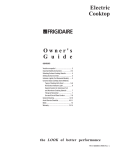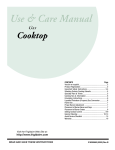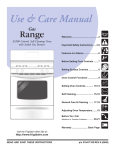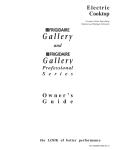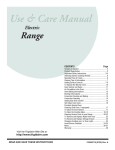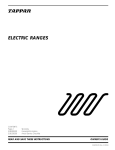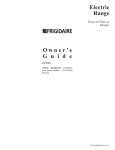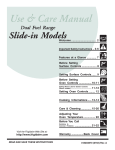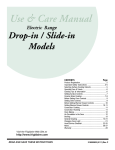Download Frigidaire 318200880 Range User Manual
Transcript
Gas R ange Range Slide-in Models Welcome .................................. 2 Important Safety Instructions .. 3-6 Features at a Glance ............. 7 Setting Surface Controls.. 8-10 Before Setting Oven Controls ................. 10-11 Setting Oven Controls ......... 11 Cooking Informations ..... 12-13 Care & Cleaning .............. 14-21 Adjusting Your Oven Temperature ................ 21 Before You Call Solutions to Common Problems ........................................... 22-23 Warranty ................ Back Cover 318200880 (0502) Rev. A Welcome & Congratulations Questions? 1-800-944-9044 (United States) 1-866-294-9911 (Canada) Please attach sales receipt here for future reference. Congratulations on your purchase of a new appliance! At Electrolux Home Products, we are very proud of our product and are completely committed to providing you with the best service possible. Your satisfaction is our number one priority. We know you’ll enjoy your new appliance and Thank You for choosing our product. We hope you consider us for future purchases. PLEASE CAREFULLY READ AND SAVE THESE INSTRUCTIONS This Use & Care Manual contains general operating instructions for your appliance and feature information for several models. Your product may not have all the described features. The graphics shown are representative. The graphics on your appliance may not look exactly like those shown. These instructions are not meant to cover every possible condition and situation that may occur. Common sense and caution must be practiced when installing, operating and maintaining any appliance. Please record your model and serial numbers below for future reference. Model Number: Serial Number: Purchase Date: Product Registration Register Your Product The PRODUCT REGISTRATION CARD should be filled in completely, signed and returned to Electrolux Home Products. Serial Plate Location Versión en español Si desea obtener una copia en español de este Manual del Usuario, sírvase escribir a la dirección que se incluye a continuación. Solicite la P/N 318200880E. Spanish Use & Care Manual Electrolux Home Products P. O. Box 212378 Augusta, GA 30917 Serial Plate Location © 2005 Electrolux Canada Corp. All rights reserved Printed in United States 2 Important Safety Instructions Read all instructions before using this appliance. Save these instructions for future reference. This manual contains important safety symbols and instructions. Please pay attention to these symbols and follow all instructions given. This symbol will help alert you to situations that may cause serious bodily harm, death or property damage. This symbol will help alert you to situations that may cause bodily injury or property damage. If the information in this manual is not followed exactly, a fire or explosion may result causing property damage, personal injury or death. FOR YOUR SAFETY: — Do not store or use gasoline or other flammable vapors and liquids in the vicinity of this or any other appliance. — WHAT TO DO IF YOU SMELL GAS: • Do not try to light any appliance. • Do not touch any electrical switch; do not use any phone in your building. • Immediately call your gas supplier from a neighbor's phone. Follow the gas supplier's instructions. • If you cannot reach your gas supplier, call the fire department. — Installation and service must be performed by a qualified installer, servicer or the gas supplier. • • • • All ranges can tip. Injury to persons could result. Install anti-tip device packed with range. See Installation Instructions. To reduce the risk of tipping, the range must be secured by properly installed anti-tip bracket(s) provided with the range. To check if the bracket(s) is installed properly, remove the lower panel or storage drawer and verify that the anti-tip bracket(s) is engaged. Refer to the Installation Instructions for proper anti-tip bracket(s) installation. • Never modify or alter the construction of a range by removing leveling legs, panels, wire covers, anti-tip brackets/screws, or any other part of the product. • Remove all tape and packaging before using the range. Destroy the carton and plastic bags after unpacking the range. Never allow children to play with packaging material. Stepping, leaning or sitting on the door or drawer of this range can result in serious injuries and also cause damage to the range. Do not allow children to climb or play around the range. The weight of a child on an open door may cause the range to tip, resulting in serious burns or other injury. • Proper Installation-Be sure your appliance is properly installed and grounded by a qualified technician in accordance with the National Fuel Gas Code ANSI Z223.1 latest edition, and National Electrical Code ANSI/NFPA No. 70 latest edition, and local code requirements. Install only per installation instructions provided in the literature package for this range. Do not use the oven or warmer drawer (if equipped) for storage. Ask your dealer to recommend a qualified technician and an authorized repair service. Know how to disconnect the electrical power to the appliance at the circuit breaker or fuse box in case of an emergency. Do not store items of interest to children in the cabinets above a range. Children climbing on the range to reach items could be seriously injured. • User servicing—Do not repair or replace any part of the appliance unless specifically recommended in the manuals. All other servicing should be done only by a qualified technician, This may reduce the risk of personal injury and damage to the range. Never use your appliance for warming up or heating up the room. 3 Important Safety Instructions IMPORTANT—Do not attempt to operate the oven during a power failure. If the power fails, always turn off the oven. If the oven is not turned off and the power resumes, the oven may begin to operate again. Once the power resumes, reset the clock and oven function. • Storage in or on Appliance—Flammable materials should not be stored in an oven, near surface burners or in the drawer (if equipped). This includes paper, plastic and cloth items, such as cookbooks, plasticware and towels, as well as flammable liquids. Do not store explosives, such as aerosol cans, on or near the appliance. Flammable materials may explode and result in fire or property damage. Electronic controllers can be damaged by cold temperatures. When you use your appliance for the first time, or if it has not been used for a long period of time, make sure that it has been exposed to a temperature above 0°C/32°F for at least 3 hours before connecting it to the power supply. • Do not leave children alone—Children should not be left alone or unattended in the area where appliance is in use. They should never be allowed to sit or stand on any part of the appliance. IMPORTANT INSTRUCTIONS FOR USING YOUR COOKTOP • DO NOT TOUCH SURFACE BURNERS, AREAS NEAR THESE BURNERS, OVEN BURNERS OR INTERIOR SURFACES OF THE OVEN. Both surface burners and oven burners may be hot even though flames are not visible. Areas near surface burners may become hot enough to cause burns. During and after use, do not touch, or let clothing or other flammable materials touch these areas until they have had sufficient time to cool. Among these areas are the cooktop, surfaces facing the cooktop, the oven vent openings and surfaces near these openings, oven door and window. Use proper flame size—Adjust flame size so it does not extend beyond the edge of the utensil. The use of undersized utensils will expose a portion of the burner flame to direct contact and may result in ignition of clothing. Proper relationship of utensil to flame will also improve efficiency. • Wear proper apparel—Loose-fitting or hanging garments should never be worn while using the appliance. Do not let clothing or other flammable materials contact hot surfaces. Do not use stove top grills on the burner grates of sealed gas burners. If you use a stove top grill on a sealed gas burner, it will cause incomplete combustion and can result in exposure to carbon monoxide levels above allowable current standards. This can be hazardous to your health. • Do not use water or flour on grease fires—Smother the fire with a pan lid, or use baking soda, a dry chemical or foam-type extinguisher. • Know which knob controls each surface burner. Place a pan of food on the burner before turning it on, and turn the burner off before removing the pan. • When heating fat or grease, watch it closely. Fat or grease may catch fire if allowed to become too hot. • Always turn the knob to the full LITE position when igniting top burners. Visually check that burner has lit. Then adjust the flame so it does not extend beyond the edge of the utensil. In case of fire or gas leak, be sure to turn off the main gas shutoff valve. • Use proper pan size. This appliance is equipped with one or more surface burners of different sizes. Select utensils having flat bottoms large enough to cover the surface burner. The use of undersized utensils will expose a portion of the surface burner to direct contact and may result in ignition of clothing. Proper relationship of utensil to the surface burner will also improve efficiency. • Use only dry potholders—Moist or damp potholders on hot surfaces may result in burns from steam. Do not let potholders touch hot heating burners. Do not use a towel or other bulky cloth instead of a potholder. • Do not heat unopened food containers—Buildup of pressure may cause container to burst and result in injury. • Remove the oven door from any unused range if it is to be stored or discarded. 4 • Utensil handles should be turned inward and not extend over adjacent surface burners. To reduce the risk of burns, ignition of flammable materials, and spillage due to unintentional contact with the utensil, the handle of the utensil should be positioned so that it is turned inward, and does not extend to adjacent surface burners. Important Safety Instructions • Keep oven vent ducts unobstructed. The oven vent is located at the center rear of the cooktop. Touching the surfaces in this area when the oven is operating may cause severe burns. Also, do not place plastic or heatsensitive items on or near the oven vent. These items could melt or ignite. • Never leave surface burners unattended at high heat settings—Boilovers cause smoking and greasy spillovers that may ignite, or a pan that has boiled dry may melt. • Protective liners—Do not use aluminum foil to line surface burner pans, or oven bottom, except as suggested in this manual. Improper installation of these liners may result in risk of electric shock, or fire. • Placement of oven/warmer drawer (if equipped) racks. Always place oven racks in desired location while oven/warmer drawer (if equipped) is cool. If rack must be moved while oven is hot use extreme caution. Use potholders and grasp the rack with both hands to reposition. Do not let potholders contact the hot heating elements in the oven/warmer drawer (if equipped). Remove all utensils from the rack before moving. • Glazed cooking utensils—Only certain types of glass, glass/ceramic, ceramic, earthenware, or other glazed utensils are suitable for range top service without breaking due to the sudden change in temperature. Check the manufacturer’s recommendations for cooktop use. • Do not use the broiler pan without its insert. The broiler pan and its insert allow dripping fat to drain and be kept away from the high heat of the broiler. • Do not use Searing Grill on the cooktop. The searing grill is not designed for use on the cooktop. Doing so may result in a fire. • Do not cover the broiler insert with aluminum foil. Exposed fat and grease could ignite. • Do not use decorative surface burner covers. If a burner is accidentally turned on, the decorative cover will become hot and possibly melt. Burns will occur if the hot covers are touched. Damage may also be done to the cooktop or burners because the covers may cause overheating. Air will be blocked from the burner and cause combustion problems. • Do not touch a hot light bulb with a damp cloth. Doing so could cause the bulb to break. Disconnect the appliance or turn off the power to the appliance before removing and replacing light bulb. IMPORTANT INSTRUCTIONS FOR CLEANING YOUR RANGE FOR GLASS COOKTOPS ONLY • Do not clean or operate a broken cooktop—If cooktop should break, cleaning solutions and spillovers may penetrate the broken cooktop and create a risk of electric shock. Contact a qualified technician immediately. • Clean the range regularly to keep all parts free of grease that could catch fire. Exhaust fan ventilation hoods and grease filters should be kept clean. Do not allow grease to accumulate on hood or filter. Greasy deposits in the fan could catch fire. When you are flaming food under the hood, turn the fan on. Refer to the hood manufacturer’s instructions for cleaning. • Clean cooktop glass with caution—If a wet sponge or cloth is used to wipe spills on a hot cooking area, be careful to avoid a steam burn. Some cleaners can produce harmful fumes if applied to a hot surface. • Kitchen cleaners and aerosols—Always follow the manufacturer’s recommended directions for use. Be aware that excess residue from cleaners and aerosols may ignite causing damage and injury. • Avoid scratching the cooktop glass with sharp objects. SELF-CLEANING OVENS IMPORTANT INSTRUCTIONS FOR USING YOUR OVEN • In the self-Cleaning cycle only clean the parts listed in this Use and Care Guide. Before self-cleaning the oven, remove the broiler pan and any utensils or foods from the oven. • Use care when opening oven door or warmer drawer (if equipped)—Stand to the side of the range when opening the door of a hot oven. Let hot air or steam escape before you remove or replace food in the oven/ warmer drawer. • Do not use oven cleaners—No commercial oven cleaner or oven liner protective coating of any kind should be used in or around any part of the oven. 5 Important Safety Instructions • Do not clean door gasket—The door gasket is essential for a good seal. Care should be taken not to rub, damage or move the gasket. Important Safety Notice The California Safe Drinking Water and Toxic Enforcement Act requires the Governor of California to publish a list of substances known to the state to cause cancer, birth defects or other reproductive harm, and requires businesses to warn customers of potential exposure to such substances. • Remove oven racks. Oven racks color will change if left in the oven during a self-cleaning cycle. The health of some birds is extremely sensitive to the fumes given off during the selfcleaning cycle of the range. Move the birds to another well ventilated room. SAVE THESE INSTRUCTIONS Grounding Instructions For personal safety, the cooktop must be properly grounded. For maximum safety, the power cord must be plugged into an electrical outlet that is correctly polarized and properly grounded. DO NOT Operate the cooktop using a 2-prong adapter or an extension cord. If a 2-prong wall receptacle is the only available outlet, it is the personal responsibility of the consumer to have it replaced with a properly grounded 3-prong wall receptacle installed by a qualified electrician. See the INSTALLATION INSTRUCTIONS packaged with this cooktop for complete installation and grounding instructions. This appliance is equipped with a 3-prong grounding plug for your protection against shock hazard and should be plugged directly into a properly grounded receptacle. DO NOT cut or remove the grounding prong from this plug. Grounding type wall receptacle Do not, under any circumstances, cut, remove, or bypass the grounding prong. Power supply cord with 3-prong grounding plug Avoid fire hazard or electrical shock. DO NOT use an adapter plug, an extension cord, or remove grounding prong from electrical power cord. Failure to follow this warning can cause serious injury, fire or death. Conversion to Liquefied Petroleum Gas (or L.P. Gas) Personal injury or death from electrical shock may occur if the range is not installed by a qualified installer or electrician. This natural gas range is designed to allow for conversion to Liquefied Petroleum (L.P.) Gas. If L.P. conversion is needed, contact the service center for assistance. The L.P. Conversion Kit is provided with this range and is located on the right panel (right side) of the range. Before installing the kit be sure to follow the L.P. Installation Instructions carefully. Any additions, changes or conversions required in order for this appliance to satisfactorily meet the application needs must be made by an authorized Service Center. 6 Features At A Glance Electronic Oven Controls with Clock and Kitchen Timer Surface Burner Control Knobs Cast Iron Grates Self-Cleaning Oven Oven Light (2) Adjustable Oven Racks One Piece Door Handle Glass Front Oven Door with Large Window Opening Insert Broil Pan Storage Drawer Oven Vent 9,500 BTU or 12,000 BTU Sealed Burner LP convertible 5,000 BTU Sealed Burner (LP convertible) Removable Surface Burner Grates (Styles and color will vary by model) 12,000 BTU or 14,000 BTU Sealed Burner (LP convertible) 9,500 BTU Sealed Burner LP convertible Glass or Porcelain Cook Top Note: The features of your range will vary according to model. 7 Setting Surface Controls Sizes of the Surface Gas Burners Your appliance is supplied with the 4 different surface gas burners: • 1 Simmer Burner (5,000 BTU) • 1 or 2 Standard Burners (9,500 BTU) • 1 Power Burner (12,000 BTU) • 1 Power Burner (14,000 BTU) Burner Cap (Standard or Extra Large) Standard or “POWER” Burner Head (9,500 BTU) or (12,000 BTU) Burner Cap (Standard) When setting up the range for the first time, make sure that the correct Burner Heads, Burner Caps and Burner Grates are located as shown in Figure 1. Left Rear Orifice Holder Standard Burner Head (9,500 BTU) Left Front Orifice Holder Extra Large Burner Cap “POWER” Burner Head (12,000 BTU) or (14,000 BTU) Small Burner Cap “SIMMER” Burner Head (5,000 BTU) Right Rear Orifice Holder Right Front Orifice Holder Grate Pin Figure 1 Assembly of the Surface Burner Heads, Burner Caps, Burner Grates and Flue Covers Burner Grate Burner Cap Cap Pilot Hole Burner Head Electrode Orifice Holder Electrode must be located properly in slot of each Burner Head Figure 2 Removable Flue Covers Inner Vent Cover Figure 3 It is very important to make sure that all of the Surface Burner Heads, Surface Burner Caps and Surface Burner Grates are installed correctly and at the correct locations. 1. Place all 4 Burner Heads in the correct locations (See Figure 1). Make sure that the correct Burner Head is placed with the corresponding Orifice Holder and that the Electrode is located properly in the slot of each Burner Head (See Figure 2). Proper Burner Head placement insures that each Burner will have the correct spark required for surface gas ignition. 2. Place the correct Burner Caps at each of the burner locations (Burner Cap Pilot Hole must face up). Each of the 4 (four) Burner Heads MUST have a Burner Cap installed to insure proper ignition and gas flame size and must be in place with the Pilot Hole facing up BEFORE placing the Burner Grates (See Figure 2). 3. Place the 2 (two) cast iron Burner Grates supplied with the range. Carefully lineup the 2 Grate Pins on each Grate with the Cap Pilot Holes in the 2 Burner Caps on each side of the range. DO NOT force the Burner Grates onto the Burner Caps. Forcing the grates down onto improperly installed Burner Heads and Burner Caps may damage the gas burners. Each Burner Cap is designed with a Cap Pilot Hole in the top center of the Cap. Visually check that ALL the Grate Pins line up into the Burner Cap Pilot Holes (See Figure 2). Properly installed Burner Grates will rest with all four Grate legs on the glass cooktop. 4. Place the 2 (two) flue covers over the inner vent cover as shown on figure 3. REMEMBER — DO NOT ALLOW SPILLS, FOOD, CLEANING AGENTS OR ANY OTHER MATERIAL TO ENTER THE GAS ORIFICE HOLDER OPENING. Always keep the Burner Caps and Burner Heads in place whenever the surface burners are in use. 8 Setting Surface Controls Control Locations of the Gas Surface Burners Your range is equipped with gas surface burners with 3 different BTU ratings. The ability to heat food quicker and in larger volumes increases as the burner size increases. The small SIMMER burner is best used for simmering delicate sauces, etc. This burner is located at the right rear burner position on the cooktop (see figure 1). The STANDARD burners can be used for most surface cooking needs. The 2 burners are located at the left front and rear burner positions on the cooktop (see figure 1). The POWER burner is best used for bringing large quantities of liquid rapidly up to temperature or when preparing larger quantities of food. The POWER burner is located at the left front burner position on the cooktop (see figure 1). Regardless of size, always select cookware that is suitable for the amount and type of food being prepared. Select a burner and flame size appropriate to the pan. Never allow flames to extend beyond the outer edge of the pan. LEFT REAR LEFT REAR RIGHT FRONT LEFT FRONT RIGHT FRONT LEFT FRONT RIGHT REAR RIGHT REAR Figure 1 Operating the Gas Surface Controls: 1. Place cooking utensil on surface burner. 2. Push the surface control knob down and turn counterclockwise out of the OFF position. 3. Release the knob and rotate to the LITE position (see figure 2). Note: All four electronic surface ignitors will spark at the same time. However, only the burner you are turning on will ignite. 4. Visually check that the burner has a flame. 5. Turn the control knob counterclockwise to the desired flame size. The control knobs do not have to be set at a particular setting. Use the knob indicator settings to adjust the flame as needed. DO NOT cook with the surface control knob in the LITE position. (The electronic ignitor will continue to spark if the knob is left in the LITE position.) Figure 2 Do not place plastic items such as salt and pepper shakers, spoon holders or plastic wrappings on top of the range when it is in use. These items could melt or ignite. Potholders, towels or wood spoons could catch fire if placed too close to a flame. In the event of an electrical power outage, the surface burners can be lit manually. To light a surface burner, hold a lit match to the burner head, then slowly turn the surface control knob to LITE. After burner lights turn the knob to desired setting. Use caution when lighting surface burners manually. 9 Setting Surface Controls Setting Proper Surface Burner Flame Size Correct RIGHT For most cooking - start on the highest control setting and then turn to a lower one to complete the process. Use the recommendations below as a guide for determining proper flame size for various types of cooking. The size and type of utensil used and the amount of food being cooked will influence the setting needed. *Flame Size High Flame Medium Flame Low Flame WRONG Incorrect Never extend the flame beyond the outer edge of the utensil. A higher flame simply wastes heat and energy, and increases the risk of being burned by the gas flame. Type of Cooking Start most foods; bring water to a boil; pan broiling. Maintain a slow boil; thicken sauces, gravies; steaming. Keep foods cooking; poach; stewing. For deep fat frying - use a thermometer and adjust the surface control knob accordingly. If the fat is too cool, the food will absorb the fat and be greasy. If the fat is too hot, the food will brown so quickly that the center will be undercooked. Do not attempt to deep fat fry too much food at once as the food will neither brown nor cook properly. *Note: Settings are based on using medium-weight metal or aluminum pans. Settings may vary when using other types of pans. The color of the flame is the key to proper burner adjustment. A good flame is clear, blue and hardly visible in a welllighted room. Each cone of flame should be steady and sharp. Adjust or clean burner if flame is yellow-orange. Before Setting Oven Controls Air Circulation in the Oven If using 1 rack, place in center of oven. If using multiple racks, stagger cookware as shown. For best air circulation and baking results allow 2-4" (5-10 cm) around the cookware for proper air circulation and be sure pans and cookware do not touch each other, the oven door, sides or back of the oven cavity. The hot air must circulate around the pans and cookware in the oven for even heat to reach around the food. 1 Oven Rack Multiple Oven Racks 10 Before Setting Oven Controls Some models are equipped with a blower which runs in baking and self-cleaning mode to keep all internal components at a cool temperature. It is possible that the blower keeps running even if the range has been turned off, until the components have cooled down. Arranging Oven Racks ALWAYS ARRANGE OVEN RACKS WHEN THE OVEN IS COOL (PRIOR TO OPERATING THE OVEN). Always use oven mitts when the oven is hot. Oven Vent Location The oven vent is located in the center rear on the cooktop. When the oven is on, warm air passes through the vent. This venting is necessary for proper air circulation in the oven and good baking results. DO NOT BLOCK OVEN VENT. Never close off the openings with aluminum foil or any other material. Removing and Replacing Oven Racks To remove, pull the rack forward until it stops. Lift up front of rack and slide out. To replace, fit the rack onto the guides on the oven walls. Tilt the front of the rack upward and slide the rack back into place. Arranging Oven Racks To bake on a single rack, place the rack in position 2 or 3. To bake on 2 racks, place the racks in positions 2 and 3. OVEN VENT OFF OFF OFF 2 LO 8 6 4 8 2 8 2 LO LO LO 8 1 E HI LIT E HI LIT E HI LIT E HI LIT 2 OFF 6 4 6 6 4 4 2 3 4 1 RECOMMENDED RACK POSITIONS FOR BROILING, BAKING & ROASTING Food Rack position 2 3 4 Broiling meats, chicken or fish 1 or 2 Cookies, cakes, pies, biscuits &muffins 2 or 3 Frozen pies, angel food cake, yeast, bread, casseroles, small cuts of meat or poultry 4 Turkey, roast or ham 4 Note: Always use caution when removing food. Setting Oven Controls Refer to the Electronic Oven Control Guide for oven settings. 11 Cooking Informations Oven Baking For best cooking results, heat the oven before baking cookies, breads, cakes, pies or pastries, etc... There is no need to preheat the oven for roasting meat or baking casseroles. The cooking times and temperatures needed to bake a product may vary slightly from your previously owned appliance. Baking Problems and Solutions Chart Baking Problems Causes Corrections Cookies and biscuits burn on the bottom. • Cookies and biscuits put into the oven before the preheating time is completed. • Oven rack overcrowded. • Allow oven to preheat to the selected temperature before placing food in oven. • Dark pan absorbs heat too fast. • Choose pan sizes that will permit 5.1 cm to 10.2 cm (2” to 4”) of air space on all sides when placed in the oven. • Use a medium-weight aluminum baking sheet. Cakes too dark on top or bottom. • Cakes put into the oven before preheating time is completed. • Rack position too high or low. • Oven too hot. • Allow oven to preheat to the selected temperature before placing food in the oven. • Use proper rack position for baking needs. • Set oven temperature 25°F/12°C lower than recommended. Cakes not done in the center. • Oven too hot. • Set oven temperature 25°F/12°C lower than recommended. • Use pan size suggested in recipe. • Use proper rack position and place pan so there is 5.1 cm to 10.2 cm (2” to 4”) of space on all sides of pan. • Incorrect pan size. • Pan not centered in oven. Cakes not level. • Range not level. • Pan too close to oven wall or rack overcrowded. • Pan warped. Foods not done when cooking time is up. • Oven too cool. • Oven overcrowded. • Oven door opened too frequently. • Place a marked glass measuring cup filled with water on the center of the oven rack. If the water level is uneven, refer to the installation instructions for leveling the range. • Be sure to allow 5.1 cm to 10.2 cm (2” to 4”) of clearance on all sides of each pan in the oven. • Do not use pans that are dented or warped. • Set oven temperature 25°F/12°C higher than suggested and bake for the recommended time. • Be sure to remove all pans from the oven except the ones to be used for baking. • Open oven door only after shortest recommended baking time. 12 Cooking Informations Broiling Broiling is a method of cooking tender cuts of meat by direct heat under the broil element of the oven. Preheating Preheating is suggested when searing rare steaks. (Remove the broiler pan before preheating. Foods will stick if placed on hot metal.) To preheat, set the control(s) to BROIL as instructed in the Owner's Guide. Wait for the element to become red-hot, usually about 2 minutes. Preheating is not necessary when broiling meats well-done. To Broil Broil on side until the food is browned; turn and cook on the second side. Season and serve. Always pull rack out to the "stop" position before turning or removing food. Determine Broiling Times Broiling times vary, so watch the food closely. Time not only depends on the distance from element, but on the thickness and aging of meat, fat content and doneness preferred. The first side usually requires a few minutes longer than second. Frozen meats also require additional time. Broiling Tips The broiler pan and it grid allow dripping grease to drain and be kept away from the high heat of the broiler. Grid DO NOT use the pan without its grid. DO NOT cover the grid with foil. The exposed grease could ignite. Should an oven fire occur, close the oven door and turn off the oven. If the fire continues, throw baking soda on the fire or use fire extinguisher. DO NOT put water or flour on the fire. Flour may be explosive. Broiler Clean-Up Tips: To make cleaning easier, line the bottom of the broiler pan with aluminum foil. DO Broiler Pan NOT cover the broiler grid with foil. To prevent grease from baking on, remove the broiler pan from the oven as soon as cooking is completed. Use hot pads because the broiler pan is extremely hot. Pour off grease. Soak the pan in HOT, soapy water. Clean the broiler pan as soon as possible after each use. If necessary, use soap-filled steel wool pads. Heavy scouring may scratch the grid. 13 Care & Cleaning Self-Cleaning Oven Self-Cleaning During the Self-Cleaning cycle, the outside of the range can become very hot to the touch. DO NOT leave small children unattended near the appliance. The health of some birds is extremely sensitive to the fumes given off during the Self-Cleaning cycle of any range. Move birds to another well-ventilated room. DO NOT line the oven walls, racks, bottom or any other part of the range with aluminum foil. Doing so will destroy heat distribution, produce poor baking results and cause permanent damage to the oven interior (aluminum foil will melt to the interior surface of the oven). DO NOT force the oven door open. This can damage the automatic door locking system. Use caution when opening the door after the Self-Cleaning cycle is completed. The oven may still be VERY HOT. DO HAND CLEAN FRAME A Self-Cleaning oven cleans itself with high temperatures (well above cooking temperatures) which eliminate soils completely or reduces them to a fine powdered ash you can wipe away with a damp cloth. Adhere to the following cleaning precautions: • DO NOT use oven cleaners or oven protective coatings in or around any part of the Self-Cleaning oven. • DO NOT clean the oven door gasket. The woven material of the oven door gasket is essential for a good seal. Care should be taken not to rub, damage or remove the gasket. • DO NOT use any cleaning materials on the oven door gasket. Doing so could cause damage. • Remove the broiler pan and insert, all utensils and any aluminum foil. These items cannot withstand high cleaning temperatures. • Oven racks do not have to be removed. If they are not removed during the Self-Clean cycle their color will turn slightly blue and the finish will be dull. After the cycle is complete and the oven has cooled, rub the sides of the oven racks with wax paper or a cloth containing a small amount of salad oil (this will make the racks glide easier into the rack position). • Remove any excessive spillovers in the oven cavity before starting the Self-Cleaning cycle. To clean, use hot, soapy water and a cloth. Large spillovers can cause heavy smoke or fire when subjected to high temperatures. DO NOT allow food spills with a high sugar or acid content (such as milk, tomatoes, sauerkraut, fruit juices or pie filling) to remain on the surface as they may leave a dull spot even after cleaning. • Clean any soil from the oven frame, the door liner outside the oven door gasket and the small area at the front center of the oven bottom. These areas heat sufficiently to burn soil on. Clean with soap and water. NOTE: Prior to setting the Self-Clean cycle, any spills remaining on the oven bottom should be removed. What to Expect during Cleaning: While the oven is in operation, the oven heats to temperatures much higher than those used in normal cooking. Sounds of metal expansion and contraction are normal. Odor is also normal as the food soil is being removed. Smoke may appear through the oven vent. DO HAND CLEAN DOOR DO NOT HAND CLEAN SEAL If heavy spillovers are not wiped up before cleaning, they may flame and cause more smoke and odor than usual. This is normal and safe and should not cause alarm. If available, use an exhaust fan during the self-cleaning cycle. NOTE: A smoke eliminator in the oven vent converts most of the soil into a colorless vapor. Note: See additional cleaning information for the oven door in the General Care & Cleaning section. To Set the Self-Clean Cycle Refer to the Oven Control Guide for Self-Clean Cycle settings. 14 Care & Cleaning (Cleaning Chart) Surfaces How to Clean Aluminum (trim pieces) & Vinyl Use hot, soapy water and a cloth. Dry with a clean cloth. Glass, Painted and Plastic Body Parts, Control Knobs & Decorative Trim Pieces For general cleaning, use hot, soapy water and a cloth. For more difficult soils and builtup grease, apply a liquid detergent directly onto the soil. Leave on soil for 30 to 60 minutes. Rinse with a damp cloth and dry. DO NOT use abrasive cleaners on any of these materials; they can scratch. Control Panels Before cleaning the control panel, turn all controls to OFF and remove the control knobs. To remove, pull each knob straight off the shaft. Clean as instructed above. Squeeze excess water from the cloth before wiping the panel; especially when wiping around the controls. Excess water in or around the controls may cause damage to the appliance. To replace knobs after cleaning, line up the flat sides of both the knob and the shaft; then push the knob into place. Porcelain Enamel Burner Grates, Cooktop Surface, Below Cooktop, Broiler Pan & Insert, Door Liner, Oven Bottom & Burner Drip Pans Clean burner grates, broiler pan and insert in the dishwasher and dry upon removal. If soils are not removed, follow the cooktop cleaning instructions below. Gentle scouring with a soapy scouring pad will remove most spots. Rinse with a 1:1 solution of clear water and ammonia. If necessary, cover difficult spots with an ammoniasoaked paper towel for 30 to 40 minutes. Rinse with clean water and a damp cloth, then scrub with a soap-filled scouring pad. Rinse and wipe dry with a clean cloth. Remove all cleaners or the porcelain may become damaged during future heating. DO NOT use spray oven cleaners on the cooktop. Stainless Steel (some models) Oven door & drawer front panel Clean stainless steel with hot, soapy water and a dishcloth. Rinse with clean water and a cloth. Do not use cleaners with high concentrations of chlorides or chlorines. Do not use harsh scrubbing cleaners. Only use kitchen cleaners that are especially made for cleaning stainless steel. Always be sure to rinse the cleaners from the surface as bluish stains may occur during heating that cannot be removed. Oven Racks Remove racks. See "To remove and to replace an oven rack" under Oven vent(s) and racks. Use a mild, abrasive cleaner, following manufacturer's instructions. Rinse with clean water and dry. After cleaning the racks, rub the sides of the racks with wax paper or a cloth containing a small amount of baby oil or salad oil (this will make the racks glide easier into the rack positions). Oven Door Use soap & water to thoroughly clean the top, sides and front of the oven door. Rinse well. You may use a glass cleaner on the outside glass of the oven door. DO NOT immerse the door in water. DO NOT spray or allow water or the glass cleaner to enter the door vents. DO NOT use oven cleaners, cleaning powders or any harsh abrasive cleaning materials on the outside of the oven door. DO NOT clean the oven door gasket. The oven door gasket is made of a woven material, on Self-Cleaning models, which is essential for a good seal. Care should be taken not to rub, damage or remove this gasket. 15 Care & Cleaning Ceramic Glass Cooktop Cleaning and Maintenance (Some models) Consistent and proper cleaning is essential to maintaining your ceramic glass cooktop Special Caution for Aluminum Foil and Aluminum Cooking Utensils 1) Aluminum foil Use of aluminum foil will damage the cooktop. Do not use under any circumstances. 2) Aluminum utensils The melting point of aluminum being much lower than that of other metals, care must be taken when aluminum pots or pans are used. If allowed to boil dry, not only will the utensil be ruined, but also permanent damage in the form of breakage, fusing or marking may affect the ceramic glass surface. Sliding aluminum or copper clad bottom pans on the cooktop can cause metal markings on the cooktop surface. These marks should be removed immediately after the cooktop has cooled using the cooktop cleaning cream. Metal marks can become permanent if not removed prior to future use. Cookware (cast iron, metal, ceramic or glass) with rough bottoms can mark or scratch the cooktop surface. Do not slide anything metal or glass across the cooktop. Do not use your cooktop as a cutting board or work surface in the kitchen. Do not cook foods directly on the cooktop surface without a pan. Do not drop heavy or hard objects on the glass cooktop, they may cause it to crack. Before cleaning the cooktop, be sure the controls are turned to OFF and the cooktop is COOL. DO NOT use a cooktop cleaner on a hot cooktop. The fumes can be hazardous to your health, and can chemically damage the ceramic-glass surface. Things to Remember 1. AVOID using bleach and don’t use ammonia to clean the ceramic surface. 2. Do not put plastic items on warm cooking areas. 3. Never slide oven racks across cooktop surface. They may scratch or metalmark the cooktop. 4. If cooktop should break, do not use cooktop or attempt to clean it. Call your authorized service technician immediately. 5. Never use a trivet or metal stand between the cooking utensil and the ceramic cooktop. The ceramic surface may be scratched, metal marked or etched by such items. 6. Sugary spills can cause pitting of your cooktop surface. Therefore, you must begin cleaning the spills while the cooktop is still hot. Use caution when following the steps below. a) Turn off all surface units and remove all pans immediately. b) Wearing an oven mitt, use a razor blade scraper to scrape the hot spill out of the cooking zone to a cooler area on the cooktop. c) Allow the cooktop to cool. 16 Care & Cleaning Ceramic Glass Cooktop Cleaning and Maintenance (Some models) Use and Care of Glass Surface Problem Cause To Prevent To Remove Fine "brown lines (tiny scratches or abrasion which have collected soil). Coarse particles (salt, sand, or grit) between bottom of cookware and cooktop that are not removed before cooking. Using incorrect cleaning materials. Clean cooktop after every use. Use cleaner creme daily. Tiny scratches are not removable. They can be minimized by continual use of cleaner creme. Such scratches do not affect cooking. Metal marking (mark or black marks). Sliding or scraping metal utensils or oven shelves across cooktop. Do not slide cookware across cooktop. Apply cleaner creme with dampened paper towel to a cooled surface. Brown streaks and specks. Cleaning with a sponge or dishcloth that has been used for other kitchen tasks. Use cleaner creme with clean damp paper towel. Use a small amount of cleaner creme with clean, damp paper towel. NOTE: Due to the high intensity of heat generated by the surface elements, the glass surface will turn green when the element will be turned off. This phenomenon is normal and the glass will come back to its original white color after it has completely cooled down. (White glass cooktops only). Cleaning Materials for Ceramic Glass Cooktop Some cleaning materials may contain an ingredient which can damage the cooktop. Use recommended materials only (see below). Cleaner cream should be used regularly. Prior to using your cooktop for the first time, apply a cleaner cream to the ceramic surface. A sample of CERAMA BRYTE® cleaner cream is supplied with your range. More are available in stores if needed. Use only recommended cleaning products and follow these basic cleaning suggestions. 1. BEFORE THE COOKTOP IS USED. Thoroughly clean and saturate the cooktop with cleaner cream. a) Dampen clean paper towel and clean unit. b) Wipe off with another clean, damp paper towel; then wipe dry. 2. For normal daily cleaning, apply a dab of cleaner cream in the center of each unit-area to be cleaned. Start with approximately 1/8 teaspoon. (Apply more if needed). Then, proceed as stated above in (a and b). 3. Make sure bottom of cookware and cooking area are clean and dry. 4. Select heat settings and cookware large enough for food and liquid. This stops boilovers and spatterings. 5. Wipe up food spills and spatters before they burn into surface. IMPORTANT Regularly use cleaner cream. If you run out of cleaner cream, use one of the cleaners listed. Be sure to get a new supply of cleaner cream. Never mix cleaning products! Mixtures may interact, with damaging or hazardous results. 17 CERAMA BRYTE® (Cleaner cream for ceramic cooktops) Care & Cleaning Ceramic Glass Cooktop Cleaning and Maintenance (some models) Use and Care of Glass Surface Do Use on Ceramic Glass Cooktop 1. Baking soda. 2. Non-impregnated plastic and nylon pads. 3. For burned on material, scrape with single-edged razor blade, held at a 30° angle. 4. Ceramic glass cleaning cream. 5. CERAMA BRYTE® cleaner cream. Do not Use on Ceramic Glass Cooktop 1. Avoid pads, that can leave marks and scratches. 2. Avoid heavy-duty cleansing powders, these can scratch, depending on their abrasiveness and cleaning pressure applied. 3. Avoid chemical oven cleaners. These can etch the cooktop surface and are caustic. 4. Avoid rust stain removers containing hydrofluoric acid. 5. Avoid using bleach and don’t use ammonia. Special Cleaning Instructions for Mineral Deposits and Discolorations Problem: A gray brown stain that is not removed when using cleaner cream. Cause: Condensation, when cooking, often collects and drips from cookware. The minerals found in water supply and foods may cause a gray or brown film to develop on cooktop. This film is so thin it cannot be felt and appears to be under cooktop. To Prevent: Daily and proper use of cleaner cream. To Remove: – Wet surface with water and sprinkle on cleaner cream. – Scrub with clean, damp paper towel until stain disappears. – Clean remaining paste away with damp paper towel. – Apply dab of cleaner cream and polish with a clean paper towel. WARNING – Do not use cleansers on a heated surface. Fumes could be hazardous. Wait for area to cool before cleaning. – Do not use cleaner cream to clean porcelain, paint or aluminium. 18 Care & Cleaning Cleaning the Burner Grates, Burner Caps, Burner Heads 1st Surface Burner Grate The Burner Grates, Burner Caps, and Burner Heads should be routinely cleaned. Keeping the burner ports clean will prevent improper ignition and an uneven flame at each burner position. Refer to the following instructions: To Remove and Replace the Surface Burner Grate, Surface Burner Cap and Surface Burner Head - Remove in the following order; (1st) Surface Burner Grate, (2nd) Surface Burner Cap, (3rd) Surface Burner Head (See Figure 1). Surface Burner 2nd Cap Surface 3rd Burner Head Electrode Orifice holder Figure 1 Surface Burner Grate Reverse the procedure above to replace the Surface Burner Cap, Surface Burner Head and Surface Burner Grate. Do not remove any burner parts from the cooktop until the burner parts have completely cooled and are safe to handle. Do not operate the surface burners without the Surface Burner Caps, Surface Burner Heads and Surface Burner Grates properly in place. To Clean the Burner Caps, Burner Heads and Grates - Use a soap-filled scouring pad or a mild abrasive cleanser to clean the surface burner caps and surface burner heads. The Grates and the outer vent covers are designed to be Dishwasher safe for cleaning. The ports (or slots) around the burner heads must be routinely cleaned. If residue still remains in these ports, use a small-gauge wire or needle to clean the slots or holes. For proper flow of gas and ignition of the burner—DO NOT ALLOW SPILLS, FOOD, CLEANING AGENTS OR ANY OTHER MATERIAL TO ENTER THE GAS ORIFICE HOLDER OPENING. ALWAYS keep the surface burner cap and surface burner head in place whenever a surface burner is in use. Surface Burner Caps Surface Burner Heads Outer Vent Covers THE COOKTOP IS NOT REMOVABLE. Do not attempt to remove or lift the cooktop. THE INNER VENT IS NOT REMOVABLE. Do not attempt to remove the inner vent cover. Use caution when replacing the burner cap so the electrode is not damaged. This may cause a delayed ignition or prevent the burner from igniting. Any additions, changes or conversions required in order for this appliance to perform satisfactorily must be made by authorized servicer. 19 Care & Cleaning Care and Cleaning of Stainless Steel (Stainless Steel models only) Some models are equipped with stainless steel exterior parts. Special care and cleaning are required for maintaining the appearance of stainless parts. Please refer to the table provided at the beginning of the General Care & Cleaning section in this Use & Care Guide. Removing and Replacing the Oven Door The door is heavy. For safe, temporary storage, lay the door flat with the inside of the door facing down. Lock engaged for door removal Figure 1 To Remove Oven Door: 1. Open the door to the fully opened position. 2. Pull up the lock located on both hinge supports and engage it in the hinge levers (Figure 1). You may have to apply a little downward pressure on the door to pull the locks fully over the hooks. 3. Grab the door by the sides, pull the bottom of the door up and toward you to disengage the hinge supports. Keep pulling the bottom of the door toward you while rotating the top of the door toward the range to completely disengage the hinge levers (Figure 2). 4. To clean oven door, follow the instructions provided in the General Care & Cleaning table. To Replace Oven Door: HINGE SLOT Door removed from the range 1. Grab the door by the sides; place the hinge supports in the hinge slots. Open the door to the fully opened position. Figure 2 2. Disengage the lock from the hinge levers on both sides (Figure 3). Note: Make sure the hinge supports are fully engaged before unlocking the hinge levers. 3. Close the oven door. Lock in normal position Figure 3 Special Door Care Instructions - Most oven doors contain glass that can break. Read the following recommendations: 1. Do not close the oven door until all the oven racks are fully in place. 2. Do not hit the glass with pots, pans, or any other object. 3. Scratching, hitting, jarring or stressing the glass may weaken its structure causing an increased risk of breakage at a later time. Removing and Replacing the External Door Glass Panel Applicable only to models with an external glass panel not held with frame. This design allows you to clean the inside face of the exterior door panel as well as the hidden face of the door inner glass. To Remove the External Door Glass Panel: 1. Remove the door as described in Removing and Replacing the Oven Door section and lay the door flat. 2. Using a screwdriver, remove the 5 screws fastening the glass & molding assembly. 3. Grasp both sides of the glass panel and slowly pull it out of the door upper molding. Lay the glass flat. To Replace the External Door Glass Panel: 1. Grasp the sides of the glass panel carefully insert the glass into the door top molding. 2. Replace the 5 locking screws. 3. Replace the door onto the range. Handle the glass panel with care. When dropped on a corner, the glass panel may shatter. This can cause several persona injury. 20 Care & Cleaning Storage Drawer Use the storage drawer for storing cooking utensils. The drawer can be removed to facilitate cleaning under the range. Use care when handling the drawer. Roller Removing and Replacing Storage Drawer Storage Drawer Roller Guide To remove the drawer: 1. Pull empty drawer out to the roller guide stop. 2. Tilt the drawer up and pull it out over the rollers. To replace the drawer: 1. Insert the rear end of the drawer into the opening. 2. Fit the drawer end rollers onto the guide rails. 3. Push the drawer in until it stops, then lift to allow the rollers to clear the roller guide stop, and push in. Front Frame Changing Oven Light Be sure the oven is unplugged and all parts are COOL before replacing the oven light bulb. Do not turn the oven light on during a self-cleaning cycle. High temperature will reduce lamp life. On some models an interior oven light will turn on automatically when the oven is opened. The oven light may be turned on when the door is closed by using the oven light switch located on the Electronic Oven control. The oven light bulb is covered with a glass shield held in place by a wire holder. THIS GLASS SHIELD MUST ALWAYS BE IN PLACE WHEN THE OVEN IS IN USE. To Replace the Light Bulb: 1. 2. 3. 4. BE SURE OVEN IS COOL Turn the power off at the main source. Wear a leather-faced glove for protection against possible broken glass. Replace bulb with a 40 Watt appliance bulb only. For self-cleaning oven, press wire holder to one side to release glass shield, change bulb and be sure to replace glass shield. Adjusting Your Oven Temperature For instructions on how to adjust the oven temperature refer to the electronic oven control guide. 21 Before you call Solutions to Common Problems OCCURRENCE POSSIBLE CAUSE/SOLUTION Range is not level. Poor installation. Place oven rack in center of oven. Place a level on the oven rack. Adjust leveling legs at base of range until the rack is level. When range is level, cooktop may appear out of alignment if countertop is not level. Weak, unstable floor. Be sure floor is level and can adequately support range. If floor is sagging or slopping, contact a carpenter to correct the situation. Kitchen cabinet misalignment may make range appear to be unlevel. Be sure cabinets are square and have sufficient room for range clearance. Cannot move appliance easily. Appliance must be accessible for service. Cabinets not square or are built in too tight. Contact a cabinet maker to correct the problem. Contact builder or installer to make appliance accessible. Carpet interferes with range. Provide sufficient space so range can be lifted over carpet. Gas line is hard-plumbed. Have a flexible C.S.A international approved metal appliance connector installed. Entire range or oven does not operate. Make sure cord/plug is plugged tightly into outlet. Service wiring is not complete. Call an authorized servicer. Electrical power outage. Check house lights to be sure. Call your local electric company for service. Surface burners can be lit manually. *Oven control beeps and displays any F code error (for example F11) Electronic control has detected a fault condition. Press STOP/CLEAR to clear the display and stop beeping. Reprogram oven. If fault recurs, record fault number. Press STOP/CLEAR and call an authorized servicer for assistance. Oven light does not work. Replace or tighten bulb. See Changing Oven Light section in this Use & Care Guide. Electrical power outage. Check house lights to be sure. Call your local electric company for service. Surface burners do not light. Surface control knob has not been completely turned to LITE. Push in and turn the surface control knob to LITE until burner ignites and then turn the surface control knob to the desired flame size. Burner ports are clogged. Clean burners. See “Cleaning the Burner Grates, Burner Caps and Burner Heads” under General Cleaning. Range power is disconnected from outlet. Be sure cord is securely plugged into the outlet. Electrical power outage. Be sure the gas supply to the range is turned “ON”. Surface burner flame burns half way around. Burner ports or slots are clogged. With the burner off, use a small-gauge wire or needle to clean ports or slots. Moisture is present after cleaning. Lightly fan the flame and allow the burner to operate until flame is full. Dry the burners thoroughly following instructions under General Cleaning. 22 Before you call Solutions to Common Problems Surface burner flame is orange. Dust particles in main line. Allow the burner to operate a few minutes until flame turns blue. Salt air in coastal areas. A slightly orange flame is unavoidable. Poor baking results. Many factors affect baking results. Make sure the proper rack position is used. Center food in the oven and space pans to allow air to circulate. Allow the oven to preheat to the set temperature before placing food in the oven. Try adjusting the recipes’ recommended temperature or baking time. If you feel the oven is too hot or cool, see “Recalibrating Your Oven Temperature” section in the Electronic Oven Control Guide. Fan noise during cooking operation. A cooling fan may automatically turn on and off to cool internal parts. It is normal, and the fan may continue to run even after oven is turned off. Flames inside oven or smoking from vent. Excessive spillovers in oven. Set self-clean cycle for a longer cleaning time. Excessive spillovers in oven. This is normal, especially for pie spillovers or large amounts of grease on the oven bottom. Wipe up excessive spillovers before starting the self-clean cycle. If flames or excessive smoke are present, stop the self-clean cycle and follow the steps under "Stopping or Interrupting the Self-Cleaning Cycle" in the Electronic Oven Control Guide. Oven smokes excessively during broiling. Meat is too close to the element. Reposition the rack to provide proper clearance between the meat and the oven boil element. Meat is not properly prepared. Remove excess fat from meat. Remove remaining fatty edges to prevent the meat from curling, but do not cut into the lean of the meat. Broiler pan used without the Broiler Pan Insert or insert is covered with foil. DO NOT use the Broiler Pan without the Broiler Pan Insert or cover the insert with foil. Broiler Pan or Broiler Pan Insert needs to be cleaned. Excessive smoking is caused by buildup of grease or food spatters. Clean the Broiler Pan and Insert on a regular basis. Oven door is open. Oven door should be closed when broiling. Self-cleaning cycle does not work. Control(s) not set properly. Follow instructions under “Oven Cleaning” in the Electronic Oven Control Guide. Self-cleaning cycle was interrupted. Stop time must be 2 to 4 hours past the start time. Follow steps under "Stopping or Interrupting the Self-Cleaning Cycle" in the Electronic Oven Control Guide. Soil not completely removed after selfcleaning cycle. Set Self-Clean cycle for a longer cleaning time. Failure to clean bottom front, top of oven or door areas outside oven seal. These areas are not in the Self-Cleaning area, but get hot enough to burn on food residue. Clean these areas before starting the Self-Clean cycle. Burned-on residue may be cleaned with a stiff nylon brush and water or nylon scrubber. Be careful not to damage the oven gasket. Excessive smoking from oven vent. Excessive spillovers in oven, especially for pie spillovers or large amounts of grease on the oven bottom. Wipe up excessive spillovers before starting the Self-Clean cycle. If flames or excessive smoke are present, stop the Self-Clean cycle and follow the steps under "Stopping or Interrupting the Self-Cleaning Cycle" in the Electronic Oven Control Guide. 23 LIMITED WARRANTY Your Range is protected by this warranty WARRANTY PERIOD THROUGH OUR AUTHORIZED SERVICERS WE WILL: THE CONSUMER WILL BE RESPONSIBLE FOR: FULL ONE-YEAR WARRANTY One year from original purchase date. Pay all costs for repairing or replacing any parts of this Costs of service calls that are listed under NORMAL appliance which prove to be defective in materials or RESPONSIBILITIES OF THE CONSUMER.* workmanship. LIMITED 2ND-5TH YEAR WARRANTY (Glass Smoothtop, Seal & Elements) Second through fifth years from original purchase date. Provide a replacement for any defective surface heating Diagnostic and any transportation and labor costs which element, deteriorated rubberized-silicone seal (upswept models are required because of service. only), or glass smoothtop that crack due to thermal breakage (not customer abuse). LIMITED WARRANTY (Applicable to the State of Alaska) Time periods listed above. All of the provisions of the full and limited warranties above Costs of the technician's travel to the home and any costs and the exclusions listed below apply. for pick up and delivery of the appliance required because of service. In the U.S.A., your appliance is warranted by Electrolux Home Products, Inc. In Canada, your appliance is warranted by Electrolux Canada Corp. We authorize no person to change or to add to any of our obligations under this warranty. Our obligations for service and parts under this warranty must be performed by us or an authorized servicer. * NORMAL RESPONSIBILITIES OF THE CONSUMER This warranty applies only to products in ordinary household use, and the consumer is responsible for the items listed below: 1. Proper use of the appliance in accordance with instructions provided with the product. 2. Proper installation by an authorized servicer in accordance with instructions provided with the appliance and in accordance with all local plumbing, electrical and/or gas codes. 3. Proper connection to a grounded power supply of sufficient voltage, replacement of blown fuses, repair of loose connections or defects in house wiring. 4. Expenses for making the appliance accessible for servicing, such as removal of trim, cupboards, shelves, etc., which are not a part of the appliance when it was shipped from the factory. 5. Damages to finish after installation. 6. Replacement of light bulbs and/or fluorescent tubes (on models with these features). EXCLUSIONS This warranty does not cover the following: 1. CONSEQUENTIAL OR INCIDENTAL DAMAGES SUCH AS PROPERTY DAMAGE AND INCIDENTAL EXPENSES RESULTING FROM ANY BREACH OF THIS WRITTEN OR ANY IMPLIED WARRANTY. Note: Some states do not allow the exclusion or limitation of incidental or consequential damages, so this limitation or exclusion may not apply to you. 2. Service calls which do not involve malfunction or defects in workmanship or material, or for appliances not in ordinary household use. The consumer shall pay for such service calls. 3. Damages caused by services performed by servicers other than Electrolux Home Products, Inc., Electrolux Canada Corp., or their authorized servicers; use of parts other than genuine Electrolux parts; obtained from persons other than such servicers; or external causes such as abuse, misuse, inadequate power supply or acts of God. 4. Products with original serial numbers that have been removed or altered and cannot be readily determined. IF YOU NEED SERVICE Keep your bill of sale, delivery slip, or some other appropriate payment record. The date on the bill establishes the warranty period should service be required. If service is performed, it is in your best interest to obtain and keep all receipts. This written warranty gives you specific legal rights. You may also have other rights that vary from state to state. Service under this warranty must be obtained by contacting Electrolux Home Products, Inc. or Electrolux Canada Corp. This warranty only applies in the 50 states of the U.S.A., Puerto Rico, and Canada. Product features or specifications as described or illustrated are subject to change without notice. All warranties are made by Electrolux Home Products, Inc. or Electrolux Canada Corp. 2004_02 USA 800•944•9044 Electrolux Home Products, Inc. P.O. Box 212378 Augusta, GA 30917 Canada 866•294•9911 (English or French) Electrolux Canada Corp. 6150 McLaughlin Road Mississauga, Ontario, Canada L5R 4C2
























